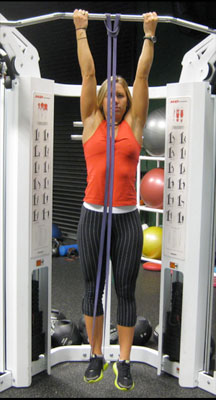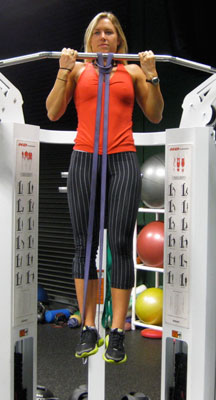Exercise of the Week
April 12, 2010 by danny · Leave a Comment
The exercise of the week is the chin-up. The chin-up is a great compound movement that works many muscles simultaneously. The latissimus dorsi is the prime mover. But other muscles of the back also come into play – the rhomboids, teres major, lower traps, etc. The biceps get a good amount of work with chins as well. Also, whenever I go a couple training blocks without doing chin-ups, my first day back at them, my abs get very sore the next day – especially when adding a lot of weight and going with lower reps. This happens because our abdominals fire like crazy to help stabilize us. As you can see, chin-ups (and pull-ups, which are done with the palms facing away from the body) are a BIG bang for-your-buck movement!
Proper Form
Start each rep from the full hang position. To initiate the movement activate the lats and picture pulling with your elbows (this helps you to pull with the proper muscles). Keep your chest high, and shoulder blades down and back. I tell me clients to, “go get the bar with your chest.” In other words, if the chest leads the way up, it will help you keep your shoulder blades down and back. As soon as you lose range of motion (you can’t get your chin above the bar), or you start shrugging your traps, stop the set. Make sure you do NOT look up and hyper-extend your neck up over the bar. You cheater you! Keep your head/neck neutral throughout (look straight forward).
The first video is a video of me doing chins with weight added. You’ll notice I pause between each rep because I am performing “classic clusters.” If interested in what a classic cluster is, you can read more about it here.
Modifications
Strength-wise, if you aren’t ready for chin-ups on your own, you can always have a partner push up on your feet on the way up, and you do all the work on the way down. Or, what we usually do is use bands for assistance. The thicker the band, the easier it is. We use bands from performbetter.com. You can see the link up and to the right of your screen. Just search for “superbands.”











